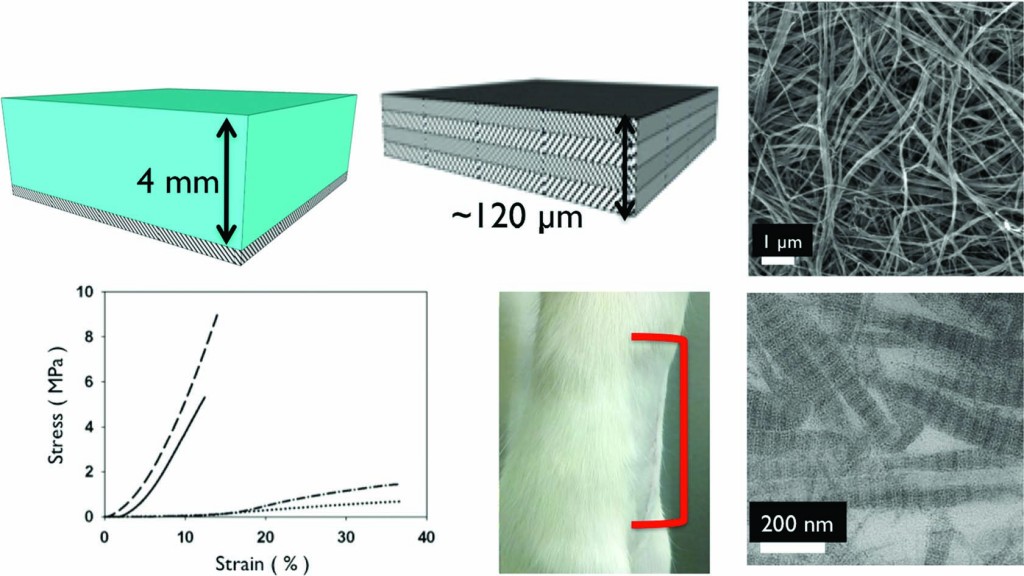Collagen has been widely used in scaffold fabrication protocols in the tissue-engineering field for decades, since the material is biocompatible and biodegradable. However, the structure of collagen molecules is often disrupted during various processing techniques (e.g. decellularization or electrospinning), which decreases the mechanical stiffness of the material. There is an urgent need to generate mechanically robust materials that integrate with the host tissue for soft tissue engineering applications.
To address this issue, Elliot Chaikof’s group at Harvard Medical School has taken a “bottom-up approach” to fabricate thick collagen mats without damaging the structure of collagen molecules. Collagen gels were cast in a rectangular mold and dried to generate a sheet of collagen approximately 15-40 microns thick. Using a layer-by-layer fabrication strategy, subsequent collagen layers were cast on top of the previous layer and dried to form 120 μm thick sheets. The casting method successfully preserves the collagen molecule microstructure, and allows for tunable mechanical properties over several orders of magnitude as a function of concentration, thickness, and number of layers.
After elegantly characterizing the material properties, the collagen mats were used in an in vivo model of ventral hernia repair. The mats were compared to commercially available PermacolTM collagen sheets currently used for hernia repair. After surgically forming a hernia in the abdomen of rats, the collagen mats were sutured on the abdominal wall. After 3 months, the collagen mats showed significantly enhanced integration at the implant site over the PermacolTM controls.
Vivek Kumar, lead author on the study, explains that the collagen mats were 65% thinner than the 1 mm thick PermacolTM matrices – potentially accounting for the enhanced integration of the mat at the implant site. Even though the collagen mats were thinner than the commercially available collagen sheets, they were able to prevent re-herniation in all the rats tested due to the comparable mechanical properties of the collagen mat to the PermacolTM matrices.
Additionally, the layer-by-layer stacking method could be used to incorporate specific drugs in between the layers (much like making a sandwich) to reduce the risk of re-herniation and stimulate new tissue formation. Kumar also claims that these collagen mats can be used for a wide array of applications, such as vascular tissue replacements, artificial skin, and dura mater replacements.
Interestingly, Kumar also suggests the method he developed is scalable. “We have cast much larger gels and much smaller gels successfully,” Kumar says. “The fabrication scheme is amenable to a variety of other geometries such as tubes and other intricate mold designs. The simplicity of our approach suggests good potential for use in industry – where often times a simpler fabrication method is better.”
This innovative research shows a simple method to create mechanically robust collagen mats that integrate exceptionally well with the surrounding tissue, and competes with current commercially available materials.
Collagen-based substrates with tunable strength for soft tissue engineering
Vivek A. Kumar, Jeffrey M. Caves, Carolyn A. Haller, Erbin Dai, Liying Liu, Stephanie Grainger and Elliot L. Chaikof
Biomater. Sci., 2013, 1, 1193-1202 DOI: 10.1039/C3BM60129C
Brian Aguado is currently a Ph.D. Candidate and NSF Fellow in the Biomedical Engineering department at Northwestern University. He holds a B.S. degree in Biomechanical Engineering from Stanford University and a M.S. degree in Biomedical Engineering from Northwestern University. When he’s not in the lab, Brian enjoys traveling, cooking, swimming, and spending time with family and friends. Read more about Brian’s research publications here.
To keep up-to-date with all the latest research, sign-up to our RSS feed or Table of contents alert.











